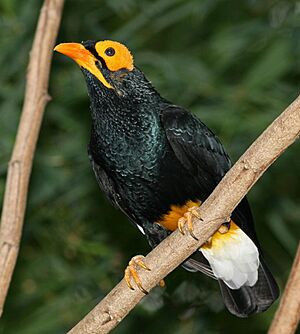Yellow-faced myna facts for kids
Quick facts for kids Yellow-faced myna |
|
|---|---|
 |
|
| Conservation status | |
| Scientific classification | |
| Genus: |
Mino
|
| Species: |
dumontii
|
The yellow-faced myna (Mino dumontii) is a cool type of starling bird. It lives in New Guinea and some smaller islands nearby. These birds like warm, wet forests in low areas. They are one of the biggest kinds of starling, growing up to 26 centimeters (about 10 inches) long. They weigh around 217 grams (about 7.6 ounces).
Yellow-faced mynas have dark feathers that look shiny, like metal. They also have bright orange skin on their face and a bright orange beak. These birds love to be with other birds. They eat both fruit and insects, which makes them omnivores. They find their food high up in the trees. These mynas are quite common, and their numbers are healthy. Because of this, they are listed as a species of "least concern" by conservation groups. This bird was named after a person called Charles Dumont de Sainte-Croix.
Contents
Meet the Yellow-Faced Myna
The yellow-faced myna is one of the largest starling species. It can grow to be between 23 and 26 centimeters (about 9 to 10 inches) long. Its head has short, black feathers that look bluish-purple and shiny. This shine is mostly on its forehead and near its beak.
Most of its head is bare, yellowish-orange skin. This skin forms a wide patch around and behind its eyes. It also makes a "bib" on its chin and the sides of its throat. The bird's neck, central throat, and back of its neck are black with a purple shine. Its back, wings, chest, and belly are black with a green shine. The lower part of its back is white. Its lower belly is golden-yellow, and the feathers under its tail are white. The tail is short, square-shaped, and black.
Most yellow-faced mynas have yellow eyes. But in some parts of New Guinea, their eyes can be brown. Both their beak and legs are yellow.
Where Do Mynas Live?
This myna bird is found only in New Guinea. It lives on the main island and many smaller islands nearby. You can often find them in many parts of their home range. They usually live in areas up to about 800 meters (about 2,600 feet) high. In some parts of Papua New Guinea, they can even be found higher up.
However, you won't find them on the southeastern coast of the main island. They like living in rainforests and at the edges of forests. They also live in areas where trees have been partly cut down. Sometimes, they are seen in areas with new plant growth or near rivers with trees. They can even be found in savannah areas, which are grasslands with scattered trees.
Myna Life and Habits
Yellow-faced mynas are sometimes seen in small groups. But you will more often find them in pairs. Sometimes, they form bigger groups, and many birds will gather together. They like to sleep in tall trees at night, with over two hundred birds in one spot!
These birds are quite noisy. They make many different sounds, like "nasal, growling, and croaking calls." Sometimes, their calls can even sound a bit like human talking. They often sit high up in a tree and call out loudly.
They fly quickly by beating their wings fast. They fly in a straight line. You will often see pairs of these birds flying together. It's possible that these birds stay with the same partner for their whole lives, which is called being monogamous.
This bird usually stays high in the trees. It mostly eats berries and fruit. But it also eats small bugs. People have even seen them catching insects while flying!
Reproduction and Life Cycle
Yellow-faced mynas build their nests in holes and cracks in trees. They choose spots that are well above the ground. Their nests are made of twigs. The female myna lays one or two pale blue eggs. These eggs have small speckles of grey and rust colors.
Sometimes, three birds have been seen carrying nesting materials into the same tree hole. This might mean that other family members help raise the young birds.


